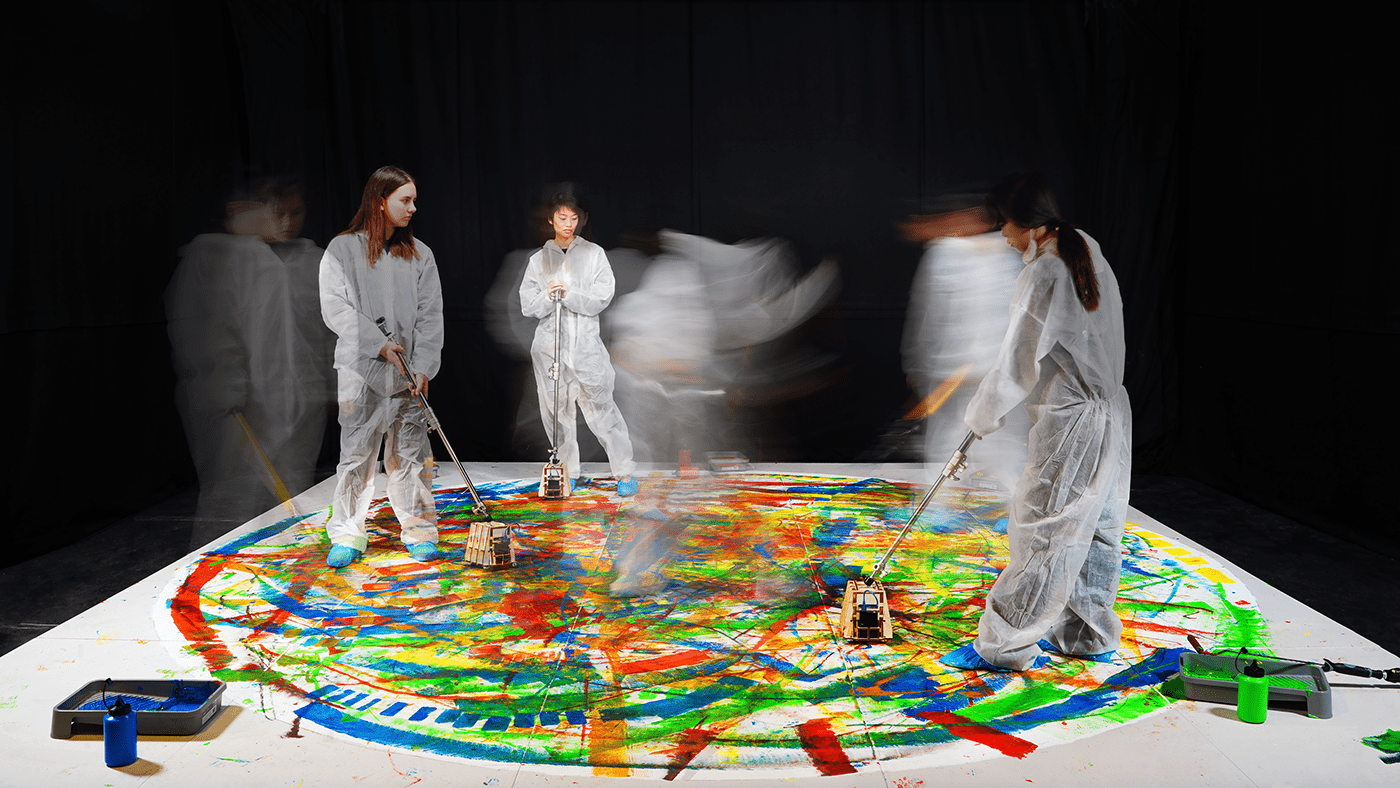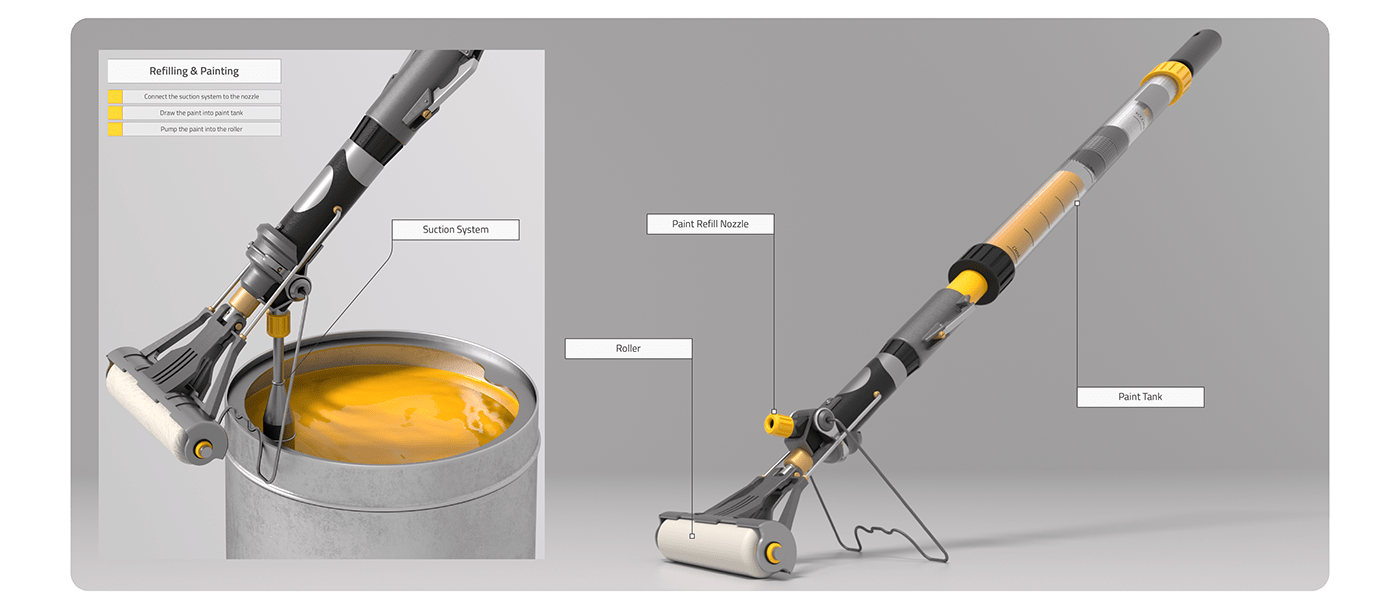

Octet on Canvas is a visual and musical performance where four composers and four performers collaborate in real-time to reimagine what musical ensemble performances can be.
The collaborative experience focuses on bringing the phenomenon of playing in a musical ensemble to people from all backgrounds. The installation brings an interactive music-creating experience between the composers and performers. Since the two perform together, the performers’ actions and interpretations directly influence how composers compose. It also goes the other way around; performers get to observe the composers compose in real-time, and that directly illustrates the composers’ compositional intentions for performers to design their own interpretations. This interactive relationship allows them to explore new grounds in the realm of musical ensemble performances.
The composers are given five colors to paint their musical ideas and elements on the canvas. Each color represents one note from the pentatonic scale; composers can unveil all twelve notes from the chromatic scale by mixing colors. The canvas illustrates and visualizes the composers' musical ideas and the trace of all interactions between the composers and performers. The eight of them together create a visual and musical performance.






As designers, we truly value the process behind every artwork; therefore, we want to showcase this aspect in Octet on Canvas. Just like any art form, the compositions performers perform are often the final product of a rigorous process with many iterations. A part of the performer's job is to read composers' manuscripts or sketches to first understand how the composition came through and to grasp the details a printed musical score cannot express. Through Octet on Canvas, we designed an experience that not only encourages composers to collaborate but also a canvas that illustrates the composition process within the performance itself.
In each performance, composers start their composition with 5 colors that represent C, D, E, G, and A on a musical scale; these five notes form a pentatonic scale. Due to the installation using sound and music as the output, the instant click between the participants and the installation heavily relies on how instinctive, relatable, and rewarding the output sounds. Through past iterations, we found out the majority of the participants prefer an outcome that sounds rewarding and pleasing. Therefore, Octet on Canvas starts off the composition with a pentatonic scale that doesn’t contain semitones. All combination of the notes within a pentatonic scale has a rewarding sound.
By collaborating with other composers on the canvas, composers can mix the default 5 colors to get a total of 12 colors which represents all 12 notes within a chromatic scale. This feature not only creates an opportunity for participants to collaborate during the performance but also illustrates the process of how musical ideas and elements come to life.













The Color Deck is designed for both composers and performers to explore the sound of different color combinations. For composers, the deck can be used to try out different harmony while they compose. On the other hand, performers have the ultimate decision on how they want to interpret and perform the composition; therefore, they can use the deck to explore different color combinations and collaborate with other performers to perform the combination that best suits their artistic vision!


Just like how artists use tools to help accomplish their artistic visions, the Composition Toolkit allows composers to create different shapes and lines to structure their compositions. We all know the canvas can easily be filled with paints, leaving blank spaces is very important if one is coming from a musical perspective; same as the concept of rests in music, composers can use these tools as a placeholder to leave blank spaces on the canvas.



Musical ensemble performances can be performed in various formats. We looked into different performance types such as ensembles performing composed compositions or ensemble improvisations.
In the case of ensembles performing composed composition, the composition has to be composed before the performance; this means the performers don’t have a direct impact on the compositional outcome*. Performers interpret the composition with their best understanding of the composer’s intent by reading the musical composition, analyzing the manuscript, or communicating with the composer. Lastly, they design their own interpretation around the given structure. Nevertheless, the relationship between a piece of composition and its performers is more of a one-way street. Composers can tweak a few details to make a better outcome, but the majority of the composition is predetermined before the composition meets its performers.
* Except the circumstances when compositions are commissioned to a specific performer or an ensemble that caters to the performers’ characteristics.

On the other hand, in the case of ensemble improvisations, performers also act as composers during performances. Depending on how an ensemble decides to execute their performance, performers can design musical structures before the performances, thus they can improvise without any plans ahead. As we learned from our past iteration, Ensemble, a group improvisation isn’t a friendly task for people coming from different backgrounds. Nevertheless, since the performers are both composing and interpreting music simultaneously, the relationship between the composition and the performers is interactive. With constant listening and interacting within the ensemble, musical elements and ideas get passed back and forth that develops into a composition.

This led us to the final concept design of our installation, Octet on Canvas. Through this performative experience, we reimagine how an ensemble performance can be. Steering away from the types of ensemble performances mentioned above, the installation brings an interactive music-creating experience between the composers and performers. An equal number of composers and performers gather on a canvas to compose and perform simultaneously. Unlike ‘Ensemble Performance Type 1’ where performers don’t have a direct impact on the composition, Octet on Canvas focuses on making the relationship between the composer, composition, and performer interactive. Since the two perform together, the performers’ actions and interpretations can directly influence how composers compose. It also goes the other way around; performers get to observe the composers compose in real-time, and that directly illustrates the composers’ compositional intentions for performers to design their own interpretations. This not only solves the problem of bringing participants into the composition process but also the challenges of ensemble improvisations. Through Octet on Canvas, every participant can be a composer or a performer to experience a different way to create musical ensemble performances.









